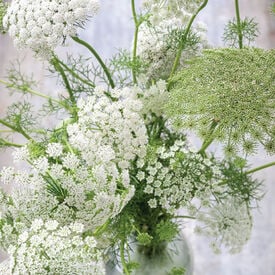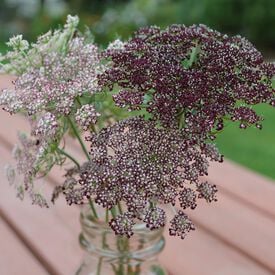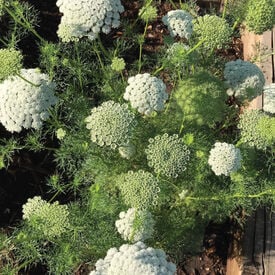White dill ammi, scientifically known as Ammi majus, is a captivating and delicate flowering plant that belongs to the Apiaceae family. This annual herbaceous plant is native to the Mediterranean region but has spread its presence to various parts of the world due to its aesthetic appeal and versatility. White dill ammi typically reaches a height of 2 to 4 feet, making it an ideal choice for both garden beds and cut flower arrangements. The plant's most distinctive feature is its lacy, fern-like foliage, which gives it a feathery and graceful appearance. The leaves are finely dissected, and the plant produces clusters of small, snow-white flowers that form intricate, flattened umbels. Each flower comprises five petals and is surrounded by numerous tiny, thread-like bracts. These blooms create a delicate, lacy, and ethereal effect, making white dill ammi a popular choice for adding texture and softness to floral arrangements. White dill ammi thrives in well-drained soil and prefers full sun to partial shade. It is a hardy and adaptable plant, growing well in a variety of soil types and conditions. It is generally cultivated from seeds, which can be sown directly in the garden or started indoors and transplanted. White dill ammi is known for its resilience and resistance to many pests and diseases, making it relatively easy to grow for both novice and experienced gardeners. Historically, white dill ammi has been cultivated for its ornamental qualities and its use in traditional herbal medicine. Its delicate blooms have made it a favorite in cottage gardens and floral arrangements for centuries. Additionally, various parts of the plant have been used in traditional medicine for their potential medicinal properties. The seeds, in particular, have been used for their carminative and digestive benefits. Today, white dill ammi remains a beloved garden plant and continues to be appreciated for its timeless beauty and versatility in both gardens and floral design.
Produces a large bloom that resembles Queen Anne’s Lace. An absolute hit that looks great with any other flowers in a flower arrangement. The lacy flowers appear in shades of old rose-pink, through burgundy to chocolate. Blooms thousands of tiny flowers on top of 2-4" clusters. The plants bloom for most of the summer from just one planting.
This Ammi makes for a great greener bouquet filler. Goes well with any color scheme. Flower heads are 3-5" wide that sit on long, sturdy stems. Also known as false Queen Anne's lace, lace flower, false bishop's weed, toothpickweed, and bishop's weed. Also great at attracting beneficial insects to the garden.



